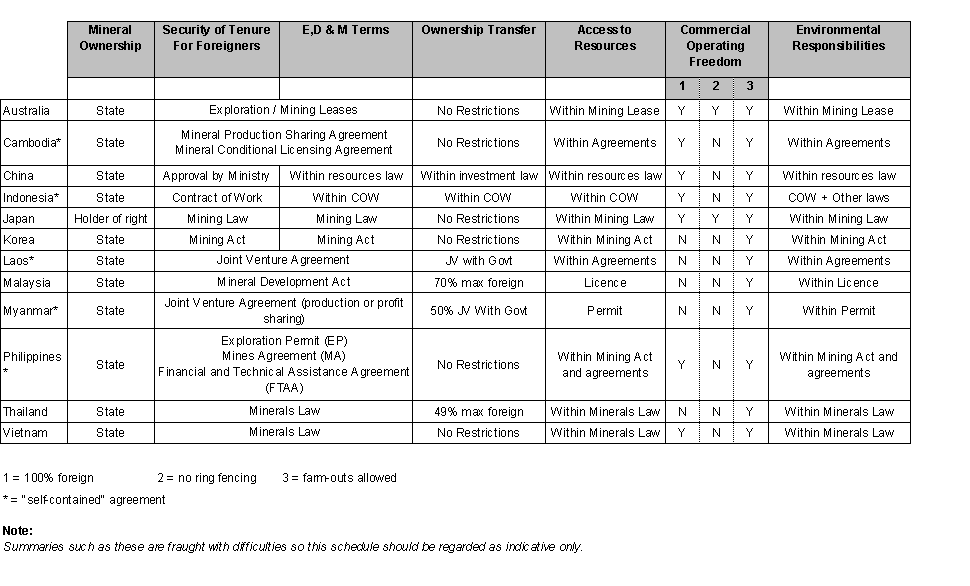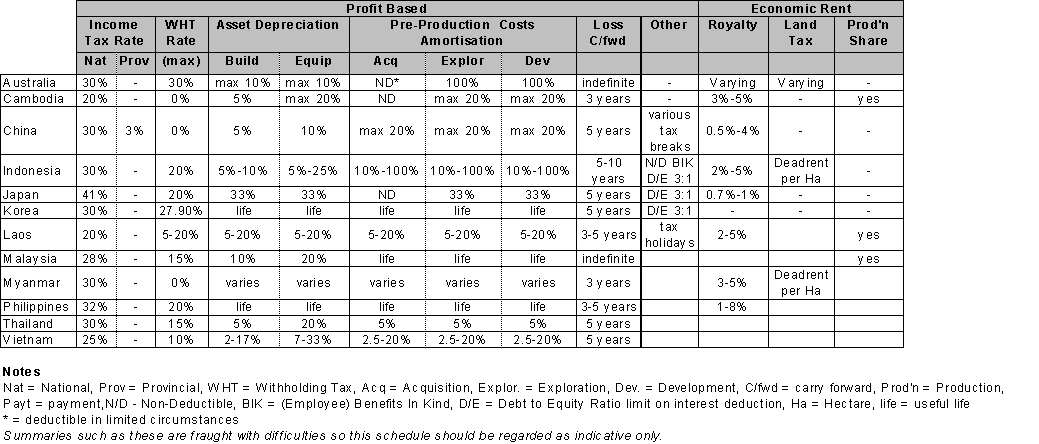Rob Hogarth
KPMG, 45 Clarence Street, Sydney NSW 2000
telephone:(02) 9335 7011
facsimile: (02) 9455 9164
e-mail: rahogarth@kpmg.com.au
KEY WORDS: taxation, mining law, financing, deductibility, interest
Non-specialists in taxation, mining law or financial matters are faced with a significant challenge in working through the implications of these areas on exploration and mine development in Asia. This paper is designed to assist non-specialists in bringing together these aspects when considering commercial issues for such projects. The key message is that whilst the local tax and mining laws have significant implications for exploration and mine development at the project level, the interaction of host country operating issues with Australian taxation and financial matters at the corporate level has at least an equally significant impact on the ultimate commerciality of the project.
Before looking at the financial implications for exploration and mine development of legal and fiscal frameworks in Asia it is helpful to first look at Australia as a frame of reference. In Australia we have a series of attractive circumstances that provide great flexibility for exploration and mine development, in particular:
1)The role of the state – is generally positive with state governments regulating exploration and mining leases;
2)Access to resources is generally favourable with:
n open title registries;
n reasonable licensing / permitting systems;
n relinquishment requirements encouraging turnover;
n free transfers; and
n availability of historical exploration data.
3)Security of tenure is generally sound with reasonable:
n renewal procedures for exploration licenses;
n maintenance requirements;
n cancellation rules; and
n flow-on rights to mine following exploration.
4)Commercial operating freedom is generally excellent with:
n few restrictions on operating controls, marketing etc;
n a developed market to manage FX and commodity price exposure;
n full transferability of ownership interests;
nflexible ownership structures particularly with unincorporated joint ventures that allow:
– flexible capital management;
– farm-in / farm-outs readily;
– flexibility for cash calls; and
– access to pre-tax cash flows.
n a developed risk capital market that provides some (albeit diminishing) access to risk capital for exploration.
5)Social licence to operate is still a developing area with:
n environmental laws increasingly providing more certainty;
n native title issues being better managed; and
n local community relationship management becoming a priority.
6)Fiscal imposts have a high degree of certainty and some favourable treatments including:
n 100% tax deductibility for exploration costs and generally interest costs;
n life of asset tax depreciation rates;
n franking credits for Australian shareholders; and
n defined input / output taxes such as WA royalties.
Accordingly, Australian projects can be viewed as follows:
 |
For Australian projects the flow through from the project to the corporate level is clear-cut, the major financial impediment being the non-tax deductibility in most cases of tenement acquisition costs. Accordingly, Australian corporates are able to effectively manage portfolios of exploration and mining projects in Australia in terms of funding, capital management and income tax.
When Australian companies become involved in exploration and mine development projects in Asia an intermediate layer of complexity is added:
 The inclusion of the country factor into consideration impacts in two key ways:
The inclusion of the country factor into consideration impacts in two key ways:
n the domestic or host country mining laws, fiscal regimes and operating environment on the project itself; and
n the interaction of those factors with the taxation and other financial aspects at a corporate level in Australia.
The host country circumstances will impact the commerciality of the project itself through the risk / reward balance. Australian companies with Asian projects are primarily concerned about pay-back periods which are influenced by host countries rules on such matters as: tax amortisation and depreciation rates, input / output taxes and requirements for local shareholding.
Exploration and mine development in Asian countries by Australian companies has some key general characteristics that drive the commerciality of projects:
1)The role of the state in developing countries is generally both as an owner and a regulator which can create issues as the state attempts to maximize its position in relation to the risk reward balance.
2) Access to resources is often restricted for foreigners creating difficulties in permitting and farm-ins / farm-outs.
3) Security of tenure varies greatly between countries with sound systems in some countries and poor systems or poor application of sound systems in others.
4) Commercial freedom is usually restricted with:
n restrictions on foreigners through shareholding limits;
n limited FX exposure management opportunities;
n a lack of available genuine domestic risk capital which means that exploration will be generally funded by the Australian company; and
n the inflexibility of in-country ownership structures remove the advantages of Australian styled unincorporated joint ventures and causes ring fencing of projects.
5) The social licence to operate is often difficult because of imprecise environmental laws, local misunderstanding of exploration and the values of most foreign companies and specific local community issues.
6) Fiscal imposts – the economics of developing countries mean that the financial imposts by the host country government are usually significant as both profit based taxes and input / output based tax which are payable regardless of profitability.
From an Australian financial viewpoint a dollar spent on, or a dollar earned from, an exploration / mining project in Asia does not have the same value as a dollar spent, or earned in, an Australian project. The key reasons for this are:
1) Exploration expenditure in Asia:
n is non tax deductible (or quarantined so as to be effectively non-deductible) in Australia when incurred directly from Australia; and
n may create value that may not be realisable because of inflexibility for farm-outs or non automatic flow-on mining rights.
2) For funding of projects in Asia:
n it is difficult to share the risk;
n thin capitalisation is likely to significantly restrict tax deductions for interest in Australia and there is in some countries the possibility of host country withholding tax being payable on interest (or deemed interest); and
n is difficult to obtain because of financial security issues.
3) Income flowing to Australia:
n is post (host country) tax giving less tax planning flexibility; and
n creates a dividend franking issue in Australia where dividends are passed through an Australian company to individual shareholders.
To explain this last point, most Asian countries require local incorporation for exploration and mining projects which means any returns back to Australia are likely to be largely via dividends. Using Indonesia as an example, it has a comparable tax rate of 30% but there is an issue with dividend withholding tax and franking credits as illustrated below:
|
|
Australian
Project
|
|
Indonesian Project
|
||
|
|
|
($)
|
|
|
($)
|
|
|
|
|
|
|
|
|
Profit / Taxable income
|
|
100.00
|
|
|
100.00
|
|
less corporate tax at 30%
|
30%
|
30.00
|
|
30%
|
30.00
|
|
|
|
|
|
|
|
|
Profit after tax
|
|
70.00
|
|
|
70.00
|
|
less dividend withholding tax
|
|
–
|
|
15%
|
(10.50)
|
|
|
|
|
|
|
|
|
Cash available to Australian company
|
|
70.00
|
|
|
59.50
|
|
less tax in Australia
|
30%
|
–
|
|
30%
|
–
|
|
|
|
|
|
|
|
|
Paid as dividend to individual shareholders
|
|
70.00
|
|
|
59.50
|
|
|
|
|
|
|
|
|
Individual shareholder taxable income
|
|
100.00
|
|
|
59.50
|
|
Tax at 47%
|
|
(47.00)
|
|
|
(27.96)
|
|
less franking credit
|
|
30.00
|
|
|
–
|
|
|
|
|
|
|
|
|
Tax
|
|
17.00
|
|
|
27.96
|
|
|
|
|
|
|
|
|
Return after tax
|
|
53.00
|
|
|
31.54
|
|
|
|
|
|
|
|
|
Effective tax rate to individual shareholder
|
|
47.00%
|
|
|
68.46%
|
|
|
|
|
|
|
|
Appendix 1 summarizes the mining law regimes in the major exploration / mining countries in Asia. Summaries such as these are fraught with difficulties, so they should be regarded as indicative only.
Mining Law regimes in most surveys typically ranks as the second most important criteria in decisions on location of exploration spending after geologic potential. The long-term nature of exploration and mining mean that certainty is the key.
Five countries have adopted a self-contained bi-lateral contractual approach in order to lock-in certainty of rights and obligations including tax, these countries are:
Cambodia
n Mineral Production Sharing Agreement
n Mineral Conditional Licensing Agreement
Indonesia
n Contract of Work
Laos
nJoint Venture Agreement
Myanmar
n Joint Venture Agreement (Production or Profits)
Philippines
n Financial and Technical Assistance Agreement
Five countries do not allow 100% foreign ownership: Korea, Laos, Malaysia, Myanmar and Thailand. All countries in the region other than Australia and Japan ring-fence exploration and mining projects.
The contract of Work (COW) system in Indonesia until a few years ago was best practice for the region with the COW locking in the mining and tax law and providing a high level of certainty. In 1998 there were 235 active COWs and over US$2 billion was spent on exploration and development but in 2002 there were 38 active COWs and expenditure was US$170 million. The COW process remains sound but the application has been overtaken by Indonesia’s continuing problems, particularly the push for regional autonomy.
Appendix 2 summarises the taxation regimes in the major exploration / mining countries in Asia. Summaries such as these are fraught with difficulties, so they should be regarded as indicative only.
Taxes can be income based or input / output based regardless of profitability. VAT / GST is such a tax but in most countries is refundable, although the refund process can be difficult. Economic Rents can also be imposed in a variety of forms including: royalties, production sharing and land taxes.
Income tax rates are generally comparable to Australia’s 30% but note the earlier comments on dividend withholding tax and franking credits. These rates should also be interpreted bearing in mind the rates for amortisation of pre-production expenses and the depreciation of non-current assets as well as other restrictions including: tax loss carry forwards, debt / equity limitations on interest deductibility as well as the whole range of input / output imposts which are not related to profit.
The summary does not have space for the many relevant other factors such as: withholding tax on interest and other charges and VAT. Tax holidays and special concessions generally do not reduce the total tax burden for Australian groups.
Whilst geology is the key determinant of the attractiveness of Asian countries for exploration by Australian companies, the mining, tax and commercial laws have a significant impact on the commerciality of projects. These impact at the project level and they also interact with Australia’s taxation and financial regimes to add a second layer of complexity to the assessment of projects. Relative to projects in Australia there are significant financial disadvantages in a portfolio of projects across Asian countries that of course may be addressed by the underlying commerciality of the individual projects.
Appendix 1 Comparison of Selected Asian Mining Laws
Appendix 2 Comparison of Selected Asian Mining Tax Laws
Review of Legal and Fiscal Frameworks for Exploration and Mining, Mining Journal Books London
Mining Metal Agency of Japan website: www.mmaj.go.jp/mmaj_e/asianlaw/asianlaw.html
Asia Pacific Taxation, 2003 KPMG
 Appendix 1 Comparison of Selected Asian Mining Laws
Appendix 1 Comparison of Selected Asian Mining Laws

Appendix 2 – Comparison of Selected Asian Mining Tax Laws